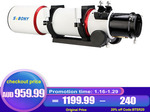I've dealt with and owned many of the products sold by SVBONY over the last couple of years. For the price, IMO they produce high quality, bang-for-ya-buck equipment. This scope can be found for $1500 plus elsewhere and compared to other brands, like Sky-Watcher for example, one of their similar telescopes the Sky-Watcher Esprit 80mm Super APO OTA sells for over $3000 here in Australia.
For anyone interested in a cheaper and less fancy telescope their SV503 80/560 ED F7 Refractor Telescope (Achromatic) is a very popular scope and currently it's $467.19 on their Amazon shop using the 20% off so make sure you apply the voucher on the page (credit to Eeples): https://www.amazon.com.au/SVBONY-Telescope-Exceptional-Viewi…
From my previous and current dealings with the company, I am acquainted with some of their staff. They are based in China but to my knowledge and past experience, orders are generally fulfilled from within Australia. I however am not employed by SVBONY (just a satisfied customer) but I'll do my best to answer any questions to the best of my knowledge (when I'm online).
Their online messages through eBay do get answered pretty quickly.
A few of this telescope's benefits are listed below:
Triplet
APO (Apochromatic)
Fully Multi-Coated
80mm aperture
f/6 focal ratio
A great portable size for travelling
Fantastic price compared to the competition.
Also they have:
A 30 day return policy
Free shipping
Customer support from 9am until midnight
There are many terminologies when it comes to astronomy and astrophotography but I've done my best to answer some of the common things I would want to know below.
FAQ:
Q: Does this come with a mount and everything I need to do astronomy?
A: No, this is an ATO only (Optical Tube Assembly) and telescopes at this level and above are often sold separately as many Astronomers/Astrophotographers are upgrading what they already have. A professional mount is not required but can cost many thousands. The SVBONY_AU eBay store sells many accessories including eyepieces and digital cameras which are also 22% off (eBay Plus) or 20% off for non eBay Plus members.
Q: What is an APO telescope?
A: APO, short for Apochromat means this telescope has very little chromatic aberration. Compared to an Achromatic, an APO is generally more expensive to produce, more complex and of a much higher quality, both in terms of visual performance and the amount of coatings on the lenses. An Achromatic OTA's use a doublet (2-element) lens while APOs use a triplet (3-element lens). APO's are generally preferred over the older Achromatic type telescopes.
Basically, the distorted blue hue colours around an object will be less obvious and the object will be clearer through an APO. Lots of information can be found about the differences online.
Q: What is Chromatic Aberration?
A: In short, different colours of light travel at different speeds through a lens and are therefore bent, this is known as dispersion, in the same way that colours of light are bent through a prism. This happens when light moves through a lens and an APO will cope with this much better than an Achromatic telescope.
Q: What is a Triplet Telescope?
A: Triplet's most importantly have a third lens. This resolves many of the above issues and adds a higher quality, complexity, build cost and performance to a telescope over a standard Doublet.
Q: Will I be able to see the Moon, large planets, galaxies and deep space objects?
A: Yes, especially if using with a guided mount and camera.
Q: Does this come with any eyepieces?
A: No, but the SVBONY_AU eBay store sells many accessories including eyepieces and digital cameras which are also 22% off (eBay Plus) or 20% off for non eBay Plus members.
Q: What does Fully Multi-Coated mean?
A: Fully multi-coated (FMC) are considered to be the "best of the best" type of coating. A FMC lens will have more than one layer of coating on all air-to-glass surfaces. It's common for cheap lenses to be simply “coated” and the most expensive and better quality to be fully multi-coated.
Q: What does the name SVBONY stand for?
A: I have no idea but I'm sure it's out-of-this-world!
This telescope would be recommended for someone who is interested in starting astrophotography (or upgrading). You can use it as a basic scope but it's kind of overkill, the SV503 might be more suited to you (link above). SVBONY make many other scopes for many different uses and price ranges. The 22% off is a real bonus and is store-wide on their eBay store. All their scopes can be found here: https://www.ebay.com.au/sch/74927/i.html?_ssn=svbony_au&stor…





To the moon !